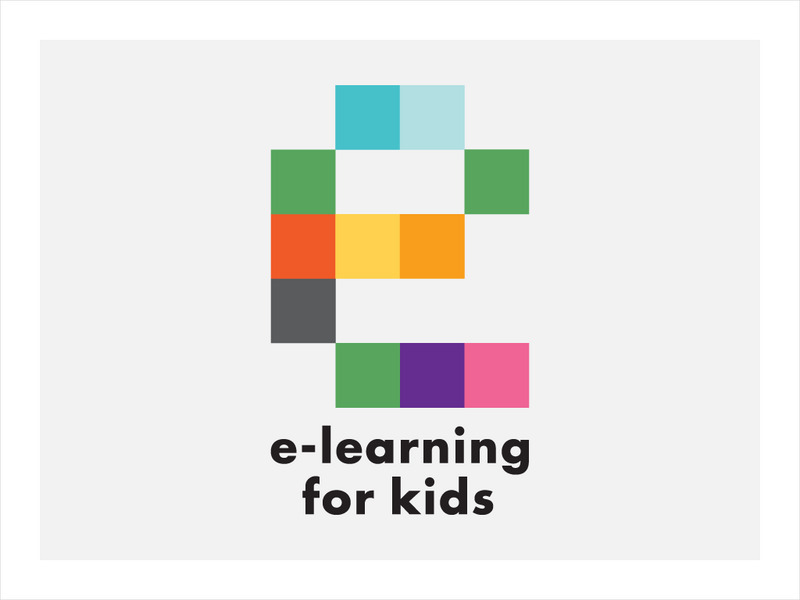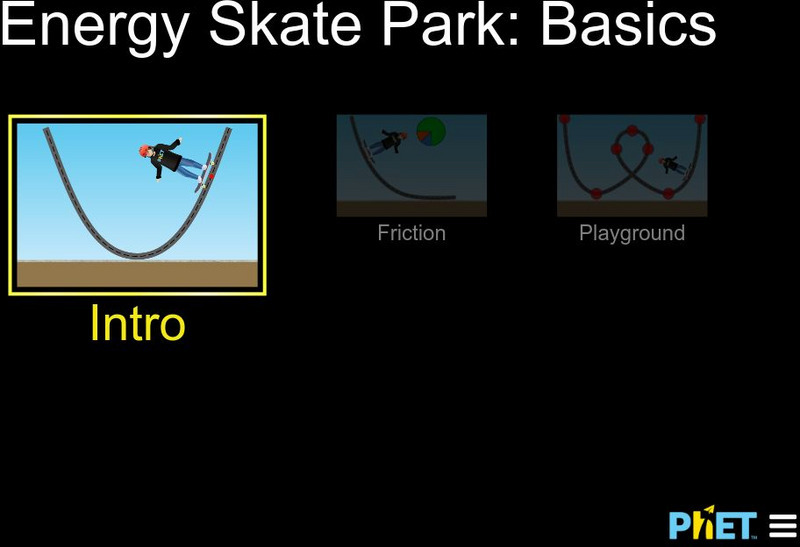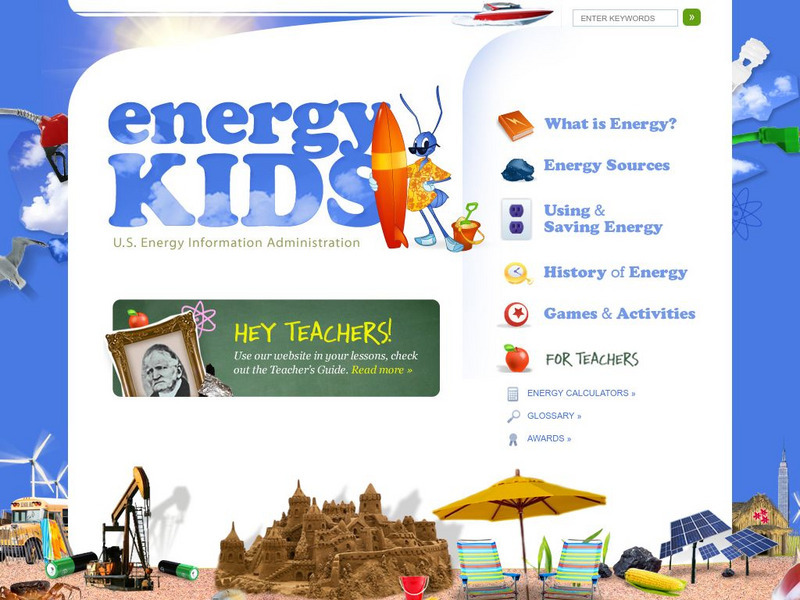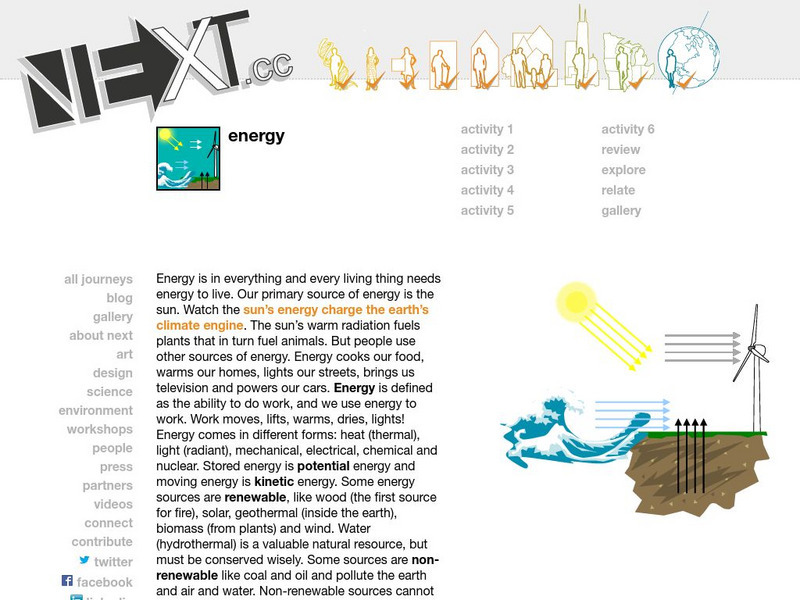Hi, what do you want to do?
CK-12 Foundation
Ck 12: Physical Science: Forms of Energy
[Free Registration/Login may be required to access all resource tools.] Introduction to the seven different forms of energy.
E-learning for Kids
E Learning for Kids: Science: Antilles: What Are the Different Forms of Energy?
Students will learn about the different types and sources of energy, including heat and light, electrical, potential, and kinetic energy.
CK-12 Foundation
Ck 12: Physical Science: Forms of Energy
[Free Registration/Login may be required to access all resource tools.] Introduction to forms of energy including the seven different forms.
CK-12 Foundation
Ck 12: Fourth Grade Science: Physical Science: Forms and Changes of Energy
[Free Registration/Login may be required to access all resource tools.] Discusses different forms of energy and how energy changes form.
Science Education Resource Center at Carleton College
Serc: Investigating Light: A Form of Energy You Can See
Students will investigate how light is a form of energy that travels as waves away from the source. The basis for this lesson is taken from the Houghton Mifflin science curriculum. In the lesson experiments, students will predict if...
University of Colorado
University of Colorado: Ph Et Interactive Simulations: Energy Skate Park
Explore kinetic, potential, and thermal energy as you send a skateboarder along several pre-built tracks, then design your own. Charts and graphs show the distribution of the different forms of energy, illustrating how the total energy...
Lumen Learning
Lumen: Boundless Chemistry: Types of Energy
This section of a chemistry textbook reviews the different forms of energy: kinetic, potential, and chemical.
SMART Technologies
Smart: Forms of Energy
Expose students to this introduction to several different forms of energy.
CK-12 Foundation
Ck 12: Physical Science: Energy
[Free Registration/Login may be required to access all resource tools.] Discusses the definition of energy, the SI unit, and the seven different forms of energy.
FT Exploring
Ft Exploring: What Type of Energy Is It?
How many types of energy are there? Are there many forms of energy, such as electrical, mechanical, and chemical? Or are there really just two types of energy - kinetic energy and potential energy? Here you can learn about these...
US Energy Information Administration
U.s. Eia Energy Kids
This comprehensive lesson teaches all about energy, including the different forms, the periodic table, history of human energy use and production, and energy units. It contains an interactive energy calculator, games and activities, and...
E-learning for Kids
E Learning for Kids: Science: Pirates: What Is Energy Conversion?
This lesson covers the different types of energy, the definitions of kinetic and potential energy, how energy can be converted into different forms, and the law of conservation of energy.
E-learning for Kids
E Learning for Kids: Science: Cayman Islands: What Is Energy Conservation?
Renewable and nonrenewable energy sources are described, different types of energy, and how energy can be conserved.
TeachEngineering
Teach Engineering: Energy of Motion
By taking a look at the energy of motion all around us, students learn about the types of energy and their characteristics. They first learn about the two simplest forms of mechanical energy: kinetic and potential energy, as illustrated...
Scholastic
Scholastic: Study Jams! Science: Matter: Energy & Matter
A video and a short quiz on the different forms of energy, and how energy moves or changes matter.
Next.cc
Next: Energy
Multiple activities explore and explain the different forms of energy, the ability to do work.
CK-12 Foundation
Ck 12: Energy and Its Forms
[Free Registration/Login may be required to access all resource tools.] Students explore the different forms of energy and investigate how the law of conservation of energy plays an important part of those forms.
Other
Characteristics of Energy and Matter
A lengthy page from the Fundamentals of Physical Geography site. Energy is distinguished from matter, and the different forms of energy are identified and discussed. Four types of heat transfer (convection, advection, conduction,...
TeachEngineering
Teach Engineering: How a Hybrid Works
In Lesson 4, students conclude the Research and Revise step of the Legacy Cycle, as they investigate different forms of hybrid engines as well as briefly conclude a look at the different forms of potential energy. Students apply basic...
Other
National Renewable Energy Laboratory: Learning About Renewable Energy
Extensive information about the different forms of renewable energy, energy efficiencies that can be achieved, energy research, and the many applications for renewable energy production.
TeachEngineering
Teach Engineering: Renewable Energy Living Lab: The Bright Idea
Students use real-world data to evaluate the feasibility of solar energy and other renewable energy sources in different U.S. locations. Working in small groups, students act as engineers evaluating the suitability of installing solar...
BBC
Bbc: Gcse Bitesize: Energy Demands
Electricity is a very convenient form of energy that can be generated using different energy resources. Some of these resources are renewable and some are non-renewable. Each resource has advantages and disadvantages. A link to a test is...
Science4Fun
Science4 Fun: Energy
What is energy? Article provides a brief discussion of the many different forms of energy.
PBS
Pbs Learning Media: Sources of Radiation
An interactive activity that discusses how radiation is like energy and comes in different forms.
























